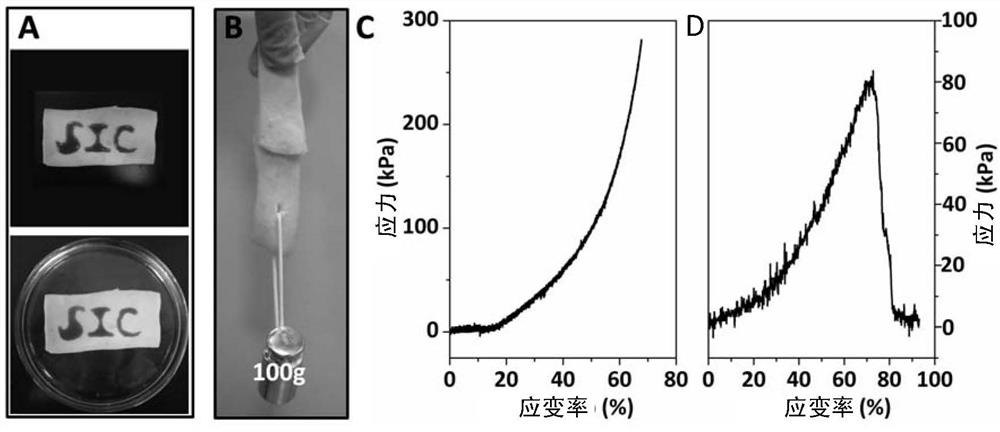A kind of composite wound dressing with tissue bonding performance and preparation method thereof
A composite hydrogel and functional group technology, applied in bandages, medical science, etc., can solve the problems of too fast gelation and unfavorable clinical use of skin wound dressings, and achieve the effect of promoting angiogenesis and wound healing process
- Summary
- Abstract
- Description
- Claims
- Application Information
AI Technical Summary
Problems solved by technology
Method used
Image
Examples
Embodiment 1
[0067] Prepare a phosphate buffer solution with a pH of 7.4, add human serum albumin powder (purchased from Sichuan Yuanda Shuyang Pharmaceutical Co., Ltd.) to dissolve and prepare a transparent liquid with a mass fraction of 20%. The dissuccinimide succinate-based polyethylene glycol powder with a molecular weight of 3500 (purchased from Beijing Jiankai Technology Co., Ltd.) was dissolved in deionized water to prepare an aqueous solution with a mass fraction of 10%. Change the chemical composition to CaO 24.5%, SiO 2 45%, Na 2 O 24.5%, P 2 o 5 6%, 45S5 bioactive glass powder with a particle size of less than 100 microns (purchased from Kunshan Huaqiao Technology New Material Co., Ltd.) was added to the phosphate buffer solution of albumin, and the mass fractions were 0.10%, 0.50%, and 1.00% respectively , 2.00%, mix well. After that, the phosphate buffer solution of albumin added with 45S5 and the aqueous solution of double succinimide succinate-based polyethylene glyco...
Embodiment 2
[0069]To prepare a phosphate buffer solution with a pH of 7.4, weigh 0.25 g of human serum albumin powder and dissolve it in 0.75 ml of phosphate buffer solution, then add 0.01 g of 45S5 bioactive glass powder with a particle size of 10 microns and mix well. Dissolve 0.1 gram of disuccinimidyl succinate-based polyethylene glycol powder with a molecular weight of 3500 in 1 ml of deionized water. The two solutions were mixed with a gelation time of 1 minute and 20 seconds to obtain a 0.50% bioactive glass / albumin hydrogel.
[0070] After testing, the tissue bonding strength of the 0.50% bioactive glass / albumin hydrogel is 81.29kPa (as image 3 (A), (B), (D) shown in), the compressive strength is 265.26kPa (such as image 3 (C) in ), and can continuously release Ca and Si bioactive ions (such as Figure 4 shown).
Embodiment 3
[0072] The chronic wound model on the back of nude mice was used to evaluate the wound repair effect of the invented hydrogel. The specific method is to create a wound with a diameter of 1 cm on the back of the nude mouse, and inject depomedrol intravenously to delay the healing. The albumin-based hydrogel and 0.5% bioactive glass / albumin hydrogel in Example 2 were evenly spread on the wound. Results from tissue staining (eg Figure 5 shown), it can be seen that after 7 days, the wounds on the back of nude mice in the 0.5% bioactive glass / albumin hydrogel group were obviously repaired, and there was obvious angiogenesis.
PUM
| Property | Measurement | Unit |
|---|---|---|
| particle diameter | aaaaa | aaaaa |
| height | aaaaa | aaaaa |
| diameter | aaaaa | aaaaa |
Abstract
Description
Claims
Application Information
 Login to View More
Login to View More - R&D
- Intellectual Property
- Life Sciences
- Materials
- Tech Scout
- Unparalleled Data Quality
- Higher Quality Content
- 60% Fewer Hallucinations
Browse by: Latest US Patents, China's latest patents, Technical Efficacy Thesaurus, Application Domain, Technology Topic, Popular Technical Reports.
© 2025 PatSnap. All rights reserved.Legal|Privacy policy|Modern Slavery Act Transparency Statement|Sitemap|About US| Contact US: help@patsnap.com



